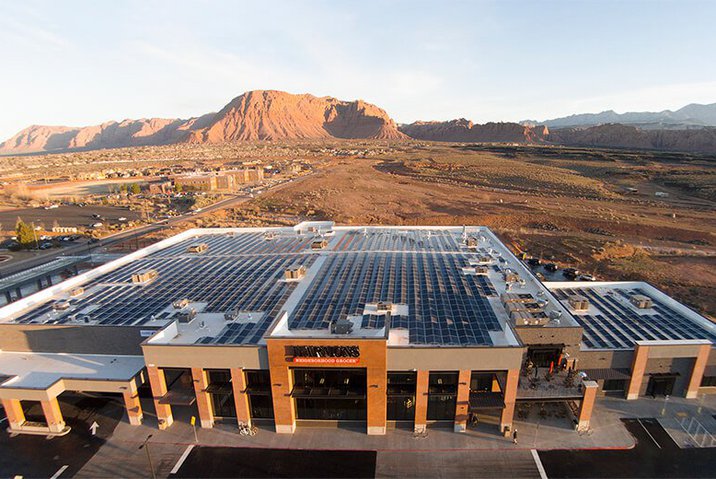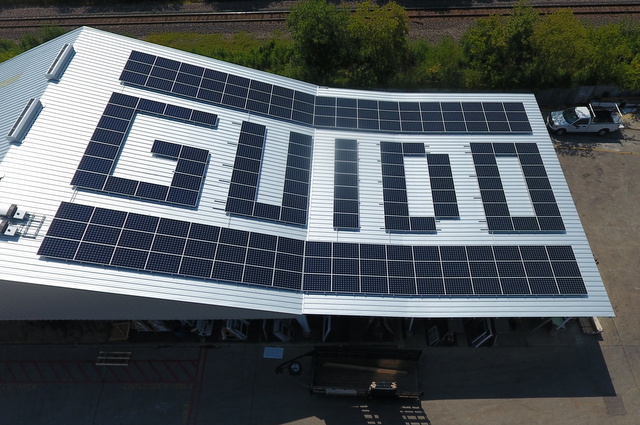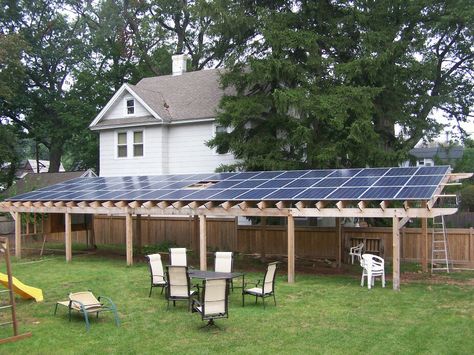Global Forum For Indurstrial Devlopment is SPONSORED BY ICO INDIA
- MP Society Registration (Act. 1973 No. 44) 03/27/01/21857/19 (MSME Forum Established Since-2009)

The Sun has been worshiped as a life-giver to our planet since ancient times. The industrial ages gave us the understanding of sunlight as an energy source. India is endowed with vast solar energy potential. About 5,000 trillion kWh per year energy is incident over India's land area with most parts receiving 4-7 kWh per sq. m per day. Solar photovoltaics power can effectively be harnessed providing huge scalability in India. Solar also provides the ability to generate power on a distributed basis and enables rapid capacity addition with short lead times. Off-grid decentralized and low-temperature applications will be advantageous from a rural electrification perspective and meeting other energy needs for power and heating and cooling in both rural and urban areas. From an energy security perspective, solar is the most secure of all sources, since it is abundantly available. Theoretically, a small fraction of the total incident solar energy (if captured effectively) can meet the entire country's power requirements.
There has been a visible impact of solar energy in the Indian energy scenario during the last few years. Solar energy based decentralized and distributed applications have benefited millions of people in Indian villages by meeting their cooking, lighting and other energy needs in an environment friendly manner. The social and economic benefits include reduction in drudgery among rural women and girls engaged in the collection of fuel wood from long distances and cooking in smoky kitchens, minimization of the risks of contracting lung and eye ailments, employment generation at village level, and ultimately, the improvement in the standard of living and creation of opportunity for economic activities at village level. Further, solar energy sector in India has emerged as a significant player in the grid connected power generation capacity over the years. It supports the government agenda of sustainable growth, while, emerging as an integral part of the solution to meet the nation’s energy needs and an essential player for energy security.
National Institute of Solar Energy has assessed the Country’s solar potential of about 748 GW assuming 3% of the waste land area to be covered by Solar PV modules. Solar energy has taken a central place in India's National Action Plan on Climate Change with National Solar Mission as one of the key Missions. National Solar Mission (NSM) was launched on 11th January, 2010. NSM is a major initiative of the Government of India with active participation from States to promote ecological sustainable growth while addressing India’s energy security challenges. It will also constitute a major contribution by India to the global effort to meet the challenges of climate change. The Mission’s objective is to establish India as a global leader in solar energy by creating the policy conditions for solar technology diffusion across the country as quickly as possible. The Mission targets installing 100 GW grid-connected solar power plants by the year 2022. This is line with India’s Intended Nationally Determined Contributions(INDCs) target to achieve about 40 percent cumulative electric power installed capacity from non-fossil fuel based energy resources and to reduce the emission intensity of its GDP by 33 to 35 percent from 2005 level by 2030.
In order to achieve the above target, Government of India have launched various schemes to encourage generation of solar power in the country like Solar Park Scheme, VGF Schemes, CPSU Scheme, Defence Scheme, Canal bank & Canal top Scheme, Bundling Scheme, Grid Connected Solar Rooftop Scheme etc.
Various policy measures undertaken included declaration of trajectory for Renewable Purchase Obligation (RPO) including Solar, Waiver of Inter State Transmission System (ISTS) charges and losses for inter-state sale of solar and wind power for projects to be commissioned up to March 2022, Must run status, Guidelines for procurement of solar power though tariff based competitive bidding process, Standards for deployment of Solar Photovoltaic systems and devices, Provision of roof top solar and Guidelines for development of smart cities, Amendments in building bye-laws for mandatory provision of roof top solar for new construction or higher Floor Area Ratio, Infrastructure status for solar projects, Raising tax free solar bonds, Providing long tenor loans from multi-lateral agencies, etc.
Recently, India achieved 5th global position in solar power deployment by surpassing Italy. Solar power capacity has increased by more than 11 times in the last five years from 2.6 GW in March,2014 to 30 GW in July, 2019. Presently, solar tariff in India is very competitive and has achieved grid parity.

New Delhi: India is at the cusp of a solar revolution, the government has already set an ambitious target to achieve 100 gigawatt (GW) by 2022. Keeping the target in mind, Indian states have already started ramping up their installed solar and wind powered capacity. ETEnergyWorld looks at the top 10 states by installed solar powered capacity. The data is provided by solar power consultancy firm Bridge To India.
If India continues to build on its gains, it will certainly reach its 100 GW solar goal by 2022. And if the nation succeeds, it’s hard to imagine the global PV sector wouldn’t follow the country’s shining example.
New Delhi: In 2010, India’s total installed solar photovoltaic (PV) capacity stood at just 10 MW. By 2022, the country hopes to install a staggering 100 GW.
At first glance, such an ambitious project may seem little daunting. Even in the best of times, scaling up that much PV capacity would be a herculean feat. However, upon closer inspection, the nation’s energy goals might not be as unachievable as they seem:
- India currently receives an average of 4 to 7 kWh per square meter of solar radiation daily, which translates to 5 quadrillion kWh of clean energy potential annually.
- The country is already proven itself a leader in solar development, having achieved its previous 2022 target of 20 GW – a full 4 years earlier than expected.
In overcoming pandemic-related challenges, however, India hopes to leverage a host of current and emerging technologies. And if successful, the nation could establish a solar template for others to follow.

Managing large-scale solar facilities has always been a complex process. Although PV technology is itself resilient – with no moving parts – there are millions of interrelated electrical components. And as the size of the facility increases, so do the maintenance and repair requirements. This explains why having “boots on the ground” is often mandatory. You need on-site technicians to monitor and service solar PV assets. The same is true for site selection, with survey teams needing to be physically present to conduct everything from geological studies to environmental impact reports.
COVID-19, however, has made this type of access difficult – creating hurdles for solar project developers and site managers throughout India and across the world. Faced with these challenges, the solar industry is now exploring how digital tools can help them unlock more of the sun’s potential – even with lockdown restrictions in place.
Although still in the early days of this digital transformation, below are some of the more promising trends worth to look at :

A wave of new SaaS companies are now helping solar stakeholders with everything from data analytics to site security to equipment monitoring to sales. Providers like SenseHawk have adopted artificial intelligence (AI) and machine learning to help independent energy producers and solar construction companies make automated real-time decision normally left to human actors.
In addition to being cheaper than using local servers and bespoke software, these scalable cloud-based solutions also benefit from real-time updates and anytime-
anywhere access (provided you have an Internet connection). Moreover, this SaaS model is also gaining traction in the B2C market, with residential solar customers able to monitor, customize, and control their PV systems from browsers or smart devices.

Although certainly not a new technology, electronic task management is helping to simplify a range of time-consuming tasks – from scheduling to equipment maintenance to quality control – all without involving paper.
This trend is happening across all industries, and solar is no exception. With the help of paperless management system specifically designed to help PV plant operators, they can manage the overwhelming number of schematics, technical manuals, warranty certifications, and other digital documents required to run large-scale solar facilities.
Aside from being cheaper and more efficient, electronic file management should be a prerequisite for any company in the business of “sustainability.”

India imports roughly 85% of its solar cells and modules from nearby China. However, Prime Minister Modi has recently committed the country to producing 36 GW of solar components domestically within next 3 years. Moreover, this lateral shift isn’t limited to physical hardware. For although many of the technologies outlined so far are being developed outside of India, the country has enough in-house IT talent to quickly close the gap if early successes generate enough interest.
A large company has already committed to a $6 billion manufacturing deal with the Solar Energy Corporation of India (SECI). And more investment will likely follow if India continues to focus on cultivating local talent and building more pandemic-resistant supply chains.

Across the globe, solar project developers and facility managers are switching to digital tools simply out of necessity. Doing so is often the only way to perform essential tasks normally reserved for human actors on the ground. What developers in India and elsewhere are quickly discovering, however, is that digitization delivers unmatched improvements in efficiency – often with faster and more accurate results.
Better still, modern technology is helping to drive down development costs by eliminating the need to hire, train, and transport large teams now that many critical tasks can be done remotely.
If India continues to build on these gains, it will almost certainly reach its 100 GW solar goal by 2022. And if the nation succeeds, it’s hard to imagine the global PV sector wouldn’t follow the country’s shining example.